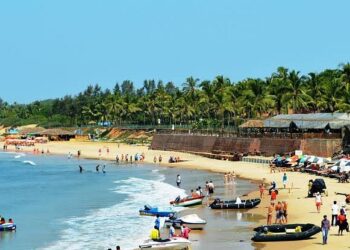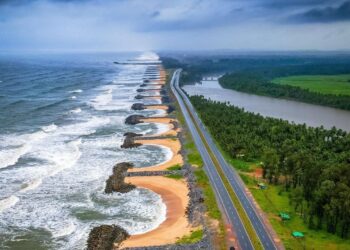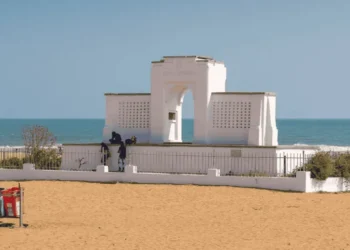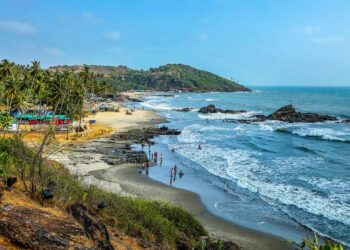Imagine a valley stirring to the soft clang of brass bells, where the wind smells of pine and prayers echo off snowy peaks.
Badrinath Temple in Uttarakhand isn’t just a monument—it’s a heartbeat, tucked high in the Garhwal Himalayas at 3,100 meters. Its story goes back to the 8th century AD, tied to sage Adi Shankaracharya, who gave it life. This small but mighty shrine to Lord Badrinarayan—Vishnu resting in peace—pulls pilgrims through tough trails and icy air. The Alaknanda River roars nearby, and the mountains stand like silent guards.
Planning a visit? Here’s how to get there, what to see, and how to survive the climb.
Fun Fact: Locals say the hot springs near the temple—called Tapt Kund—can heal you, and every May, the gates open with chants filling the valley.
Reaching Badrinath Temple
By Air
Jolly Grant Airport in Dehradun is 315 km away—a 9-10 hour drive through winding roads and misty hills. Taxis cost 6,000-8,000 INR; shared jeeps drop to 800-1,200 INR if you squeeze in. Flights come from Delhi or Lucknow—book early for cheaper seats.
By Road
Haridwar’s 320 km off—10-11 hours by bus (500-1,000 INR) or car on NH58, past tea stalls and rocky cliffs. Rishikesh is 295 km, about 9 hours (400-900 INR). Roads twist tight, landslides hit in monsoon—check weather before you go. From Joshimath, 45 km away, buses run for 100-200 INR—slow but steady.
By Train
Rishikesh Railway Station’s the closest, 295 km away. The Yog Nagari Express from Delhi (6-7 hours, 300-800 INR) gets you there. Then, hop a bus or taxi to Badrinath—another 9 hours. Trains are rare—plan ahead or you’re stuck.
Entry Fees and Visiting Hours
Operating Hours: May to November, 4:30 a.m.–9 p.m. (closed in winter—snow locks it shut).
Admission Costs: Free entry—donations welcome. Photography’s fine outside; inside’s off-limits. Hot springs dip costs 50 INR—bring a towel.
Architecture of Badrinath Temple
The temple’s small but bold—black stone walls rise 15 meters, topped with a gold dome that glints in the sun. Its Garhwal style has a curved roof, like a hut against the snow. Inside, Badrinarayan’s idol sits calm—black, 1 meter tall, carved smooth with Vishnu’s four arms. Two smaller shrines hug it—one for Lakshmi, one for saints. The walls are plain, no fancy carvings—just solid rock worn by time. Outside, the Tapt Kund springs steam up, sulfur stinging your nose. Pilgrims splash in before praying—hot water cuts the mountain chill. The valley stretches wide around it, peaks like Neelkanth watching over. It’s simple, rugged, and feels holy without trying.
History and Mythology
Local tradition claims Lord Vishnu meditated in this valley, seated on the ground among the Himalayan peaks, until Lakshmi transformed into a badri tree—a wild ber fruit tree—to provide shade, giving Badrinath its name. In the 8th century, Adi Shankaracharya, a scholar and reformer, discovered the black stone idol submerged in the Alaknanda River near the current temple site. He retrieved it and established the shrine around 790 AD, using local timber and rock to house the deity. Historical records suggest Gupta kings, ruling from the 4th to 6th centuries, may have funded early repairs or added small structures, though no clear documents survive—only temple inscriptions hint at their role. Mughal armies, active in the plains by the 16th century, bypassed it; the 3,100-meter altitude and harsh trails kept them away. Each November, priests seal the temple doors before snow buries the path, placing lit oil lamps inside the sanctum. When they return in May, after six months, the lamps remain burning—a phenomenon tied to careful wick trimming and oil reserves, yet locals call it divine. Now part of the Char Dham pilgrimage, it draws thousands annually; many walk the final stretch from Joshimath, some shoeless, crossing icy streams and rough stone to reach it.
Accommodations near Badrinath Temple
Hotel Snow Crest (1 km, 5-min walk)
Warm rooms, thick blankets, and tea that steams. Costs 2,500-4,000 INR—pricey for the basics, but heat’s a blessing.
Narayan Palace (0.8 km, 3-min walk)
Close to the temple hum—clean beds, hot water if you’re lucky. Runs 1,800-3,000 INR—book early.
GMVN Tourist Rest House (1.5 km, 7-min drive)
Government-run, no frills—beds creak, walls are cold. Cheap at 1,000-2,000 INR—good for tight wallets.
Hotel Kalash (0.5 km, 2-min walk)
Right in the buzz—small rooms, fans instead of heaters. Costs 1,200-2,500 INR—rough but close.
Dining Options Close to Badrinath Temple
Sakshi Restaurant (0.7 km, 3-min walk)
Aloo parathas come hot, chai burns your tongue—150 INR fills you. Small and noisy.
Badrinath Dhaba (1 km, 5-min walk)
Dal’s thick, rice steams—simple hill food for 120-180 INR. Cold winds sneak in; eat fast.
Shankar Café (0.5 km, 2-min walk)
Maggi noodles and tea—cheap at 80-130 INR. Quick stop for tired legs.
Annapurna Eatery (1.2 km, 6-min drive)
Roti and sabzi hit the spot—150-200 INR. Locals crowd it; service lags.
Travel Tips for Badrinath Temple
Dress Warm: Layers—jackets, scarves, socks. Summer’s cool, pre-winter bites—boots help on rocky paths.
Best Time: May-June for clear roads; October’s crisp but risky. Avoid monsoon—mudslides kill.
Cash Only: ATMs are far—carry 10-100 INR notes for food, rides.
Stay Hydrated: Bottled water’s 20 INR—altitude dries you out.
Side Trip: Mana Village, 3 km off, is India’s last hamlet—30 INR jeep, tea stalls, and caves.
Health Check: High altitude—bring meds for headaches, breathlessness. Walk slow.
Final Thoughts
Badrinath Temple isn’t a quick stop—it’s a trek into something raw and still. Chase the myths, soak in the springs, or just feel the mountains press in. It’s quiet but loud with faith. Step up, breathe deep, and leave with cold air in your lungs.











